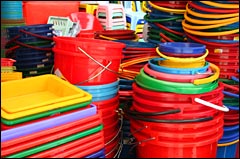Dear Umbra,
How much oil is used to make a pound (or some other comparable measure) of typical plastics?
Melody Evans
Paris, Ill.
Dearest Melody,
Ah, Paris. Is it as lovely in the springtime as they say?

Yes, Ben, plastics …
Photo: The Graduate (1967)/MGM
Your question is a good and tricky one. Let’s start with a look at how plastic is made. Manufacturers take simple hydrocarbons from whatever source material they’re using — commonly crude oil, but also natural gas, corn, and other biomass — and turn them into polymers, a fancy word for chains of molecules. In the case of crude oil, they do this by heating it to more than 750 degrees Fahrenheit, then separating its components. The polymers usually travel onward in life in the form of pellets, ending up at one plastic factory or another to be molded into familiar shapes. The pellet system has worked out well for recycling, because recycled plastic is shredded into flakes, which are easily melted and turned back into pellets.
You are probably familiar with the basic types of plastic, though you may not know their science-y names, which are often abbreviated on the bottom of your household products. Polyethylene (HDPE or LDPE) is the soft one you likely encounter most, in milk jugs, shampoo bottles, plastic bags, and so forth. Polystyrene (PS) is the hard plastic that makes casings for computers and other appliances, and also the basis of the foam product we fondly (but trademark infringingly) call Styrofoam. Polypropylene (PP) is used in dishwasher-safe containers and is also the magical fiber that rugged outdoorspeople favor. You’ll often find polyethylene terephthalate (PET) in soda bottles, and it is sometimes recycled into fleece, upholstery fabrics, and other useful materials. And then of course there’s polyvinyl chloride (PVC) — no vinyl, and that’s final.

How does plastic stack up in terms of oil use?
Photo: iStockphoto
So how much oil is consumed by this process? This is the tricky part. From what I can tell, plastic production is a bit like leather production: it’s one part of a complicated harvest. When crude oil is refined, its various chemical bits are separated. Some become gasoline, some diesel fuel, some motor oil, and others the raw material for plastics. The best estimate I could find says that about 4 percent of the world’s annual oil production of some 84.5 million barrels per day is used as feedstock for plastic, and another 4 percent or so provides the energy to transform the feedstock into handy plastic.
Let’s say a foam cup is what you had in mind as a “typical” plastic. In a classic study that closely examined the inputs for a foam cup vs. a paper cup and found the paper cup wanting, the petroleum inputs to the foam cup were 3.2 grams. (I’ll leave it to you to weigh a foam cup if you want to, because I do not have one on hand, and I want you to feel empowered and participatory.) I’ve also seen it described slightly differently, that it requires about 1.78 kilograms of petroleum feedstock to make a kilogram of polystyrene.
We could make and use fewer petroleum-based plastics, but I don’t know how much that would cut into oil drilling. Recycling, however, does cut into energy use. According to the U.S. EPA, manufacturing new plastic from recycled plastic requires two-thirds of the energy used in virgin plastic manufacture. I have more numbers, too: one ton of recycled plastic saves 685 gallons of oil. You can find lots of these “x amount is saved when we recycle” numbers in recycling promotional literature.
Abruptly,
Umbra


